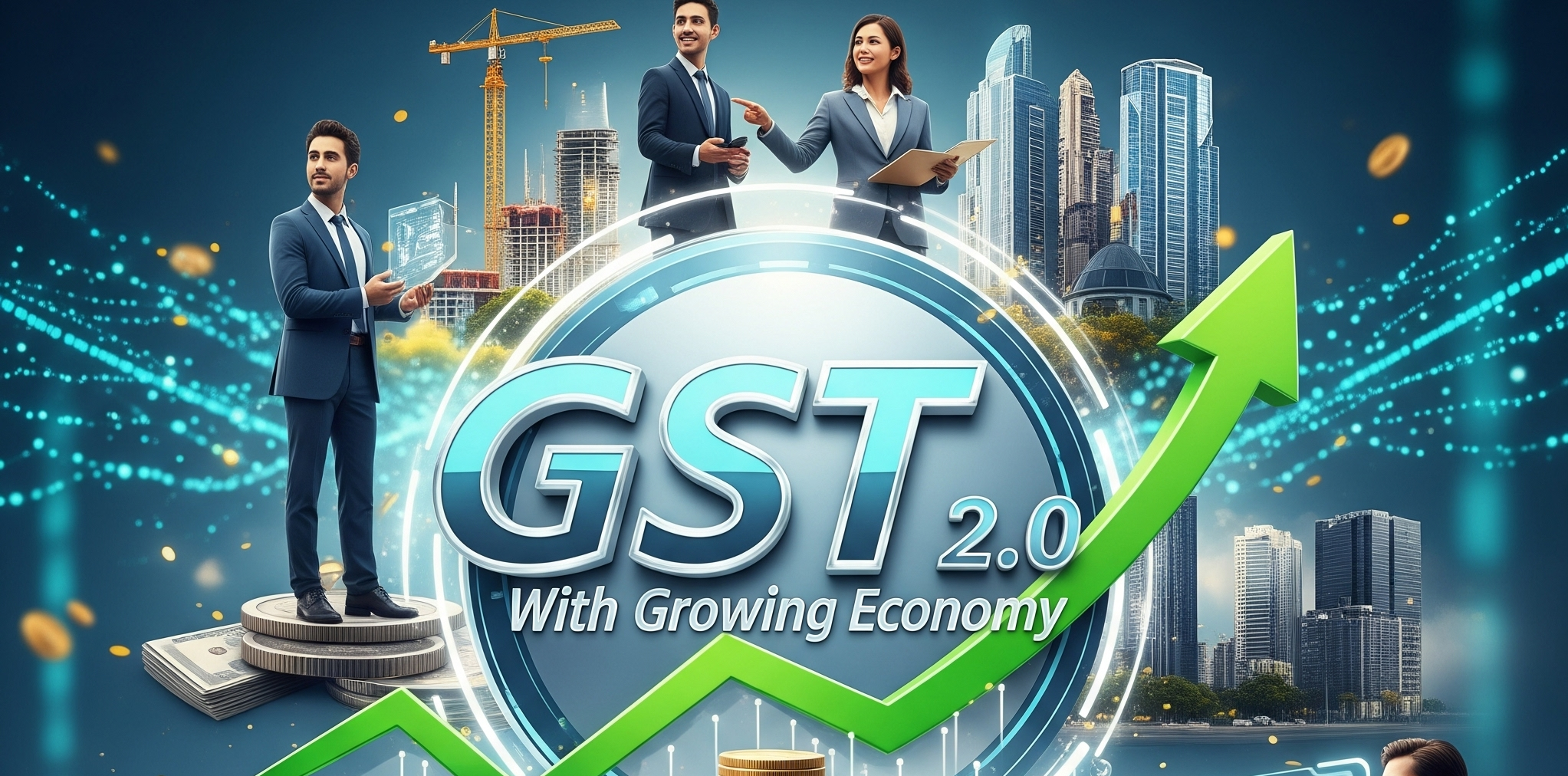India’s tax system is getting an upgrade with GST 2.0. The first GST, launched in 2017, had combined many indirect taxes into one system. Now, GST 2.0 aims to make things simpler and easier for everyone. It will reduce taxes on many everyday items, bring fewer tax slabs, and make compliance easier for businesses. Overall, this new version is designed to help people save money and give a boost to the economy.
Let’s understand what GST 2.0 brings to India’s tax system. This new version focuses on fewer tax slabs, lower taxes on essential items, and exemptions on important services. It also aims to simplify the system, reduce paperwork, and make taxation more transparent.
What is GST 2.0?
GST 2.0 is the upgraded version of India’s Goods and Services Tax system. Instead of being a new tax, it improves the existing GST by making compliance easier, cutting down paperwork, and strengthening digital processes. It also addresses loopholes to prevent tax evasion and has been shaped by feedback from businesses, tax experts, and government authorities.
Key Highlights of GST 2.0 in 2025
1. Simplified Tax Rates
Earlier, India’s GST had four slabs—5%, 12%, 18%, and 28%. With GST 2.0, these rates have been streamlined for simplicity. Essential items are either exempt or taxed at 5%, making basic goods more affordable. Standard products are placed under the 18% slab for consistency, while luxury and sin goods are taxed at 40%, creating a fairer system and discouraging non-essential spending.
2. Consumer Relief and Industrial Boost
GST 2.0 has reduced taxes on essentials like medicines, soaps, shampoos, packaged foods, and daily-use household items, helping families save more and improving consumer confidence. At the same time, lower GST on small cars, bikes, and appliances such as TVs and refrigerators is expected to raise demand. This growing demand will benefit industries, boost manufacturing, create new jobs, and support overall economic growth—making the reform beneficial for both consumers and businesses.
3. Industry Response and Festive Boost
Automobile brands like Kia, Skoda, Hero, Yamaha, and TVS quickly reduced prices after GST 2.0, with some models seeing major cuts that drew more buyers to showrooms. This price drop built excitement in the market right before the festive season. Expecting higher demand, companies increased their advertising and promotions, while dealers noted a rise in bookings. Overall, the reform has fueled festive spending, encouraging people to buy big-ticket items and giving industries strong momentum.
4. Fiscal Trade–offs and National Strategy
GST 2.0 may lead to a revenue shortfall of around ₹48,000 crore, but it is viewed as a strategic investment to stimulate the economy. By reducing taxes on essential and daily-use items, consumer spending and overall economic activity are expected to rise. The additional revenue generated from increased demand and stronger business performance could help offset the initial loss. These tax cuts also provide support to industries facing slower exports due to higher U.S. tariffs, striking a balance between immediate fiscal impact and long-term growth.
5. Simplifying Compliance
GST 2.0 aims to make tax compliance much easier, especially for small businesses. With features like automatic refunds, prefilled returns, and simpler registration processes, the system reduces the time and effort needed to manage taxes. Integrated digital platforms will allow businesses to handle all filings and payments in one place, cutting through bureaucratic hurdles. This not only saves time and resources but also helps small enterprises focus more on growth and operations rather than paperwork, making the overall tax experience smoother and more efficient.
6. Governance and Institutional Strengthening
GST 2.0 goes beyond simplifying taxes and compliance by improving governance and institutional support. It includes Aadhaar integration for accurate taxpayer identification, AI-based analytics to spot irregularities and prevent tax evasion, and a dedicated appellate tribunal to resolve disputes faster. Enhanced grievance mechanisms also help address taxpayer issues more quickly. These steps make the GST system more transparent, efficient, and fair for both businesses and individuals.
Features of GST 2.0
1. Unified Portal – The Unified Portal acts as a single, integrated platform that streamlines all GST-related tasks for taxpayers. It allows users to easily access and manage various GST services, such as filing returns, paying taxes, and resolving disputes.
2. Auto-populated Returns – The auto-populated returns feature streamlines the GST filing process by automatically populating return forms with data provided by suppliers. This reduces the need for manual input, saving taxpayers both time and effort. By using information directly from supplier invoices and transaction records, it also lowers the chances of errors and inconsistencies that often occur with manual entries.
3. Real-Time ITC Reconciliation – The real-time ITC (Input Tax Credit) reconciliation feature allows taxpayers to quickly match their purchase and sales records with supplier-provided data. This helps ensure that input tax credit claims are precise and fully compliant with GST rules. By spotting discrepancies right away, the system minimizes errors, prevents disputes, and lowers the risk of penalties.
4. AI and Analytics Integration – The AI & Analytics Integration feature uses advanced artificial intelligence and data analysis to strengthen GST compliance and monitoring. By examining large sets of transaction data in real time, it can spot irregular patterns, mismatches, or anomalies that may signal risks or possible fraud. This proactive system automatically generates alerts, enabling taxpayers and authorities to resolve issues early before they become serious.
5. Expanded E-invoicing Mandate – The expanded e-invoicing mandate brings more businesses under the requirement to generate standardized digital invoices within the GST system. This ensures consistency in invoice formats, making reporting, verification, and compliance easier. Since these invoices are automatically uploaded to the GST portal, it cuts down on manual work, lowers the chances of errors, and improves real-time accuracy in data reporting.
Benefits of GST 2.0
- For Small and Medium Businesses – GST 2.0 eases compliance for SMEs by introducing simplified forms and auto-filled data, which reduces the paperwork and effort required in filing. Refunds are processed more quickly, ensuring better cash flow management for businesses. Additionally, with reduced dependence on tax consultants and less manual work, SMEs are able to cut down on operational costs and focus more on growth.
- For Large Corporations – GST 2.0 brings greater transparency to the system, which helps reduce disputes and lengthy litigation. The new structure enables seamless reconciliation across supply chains, making transactions more efficient and reliable. With real-time data sharing, companies also benefit from smoother credit flow, ensuring better cash management and improved business operations.
- For Taxpayers and Consumers – GST 2.0 helps taxpayers and consumers by lowering the risk of tax evasion, which supports stable pricing in the market. It also offers better clarity on how taxes are levied and transferred, making the process easier to follow. This level of transparency enhances consumer trust and strengthens confidence in the fairness of the tax system.
- For the Government – GST 2.0 strengthens tax compliance and boosts the efficiency of revenue collection by ensuring accurate reporting and timely payment of taxes. Its real-time monitoring feature enables early detection of irregularities and fraud, while the availability of more reliable data helps the government in effective economic planning and smarter policy decisions.
How GST 2.0 Simplifies Taxation for All?
GST 2.0 takes a user-centric approach to simplify and streamline tax compliance for all. With easier return filing, businesses face fewer forms and deadlines, easing the burden of multiple submissions. Pre-filled returns, along with better input tax credit (ITC) reconciliation, reduce errors and remove unnecessary guesswork from the process.
The system also makes effective use of technology such as AI and e-invoicing to manage complex tasks in the background, freeing businesses to concentrate on their core operations. Automated processes speed up refund approvals, which is especially valuable for exporters and small enterprises that rely on steady cash flow. In addition, GST 2.0 enhances transparency through well-defined rules, compliance ratings, and real-time monitoring, minimizing disputes and unexpected issues while fostering greater trust in the tax system.
Final thoughts
GST 2.0 marks a significant advancement in India’s economic reforms. By using technology, streamlining compliance, and improving transparency, it seeks to build a tax system that is both business-friendly and taxpayer-friendly. The reform aims to make taxation simpler, more consistent, and more efficient for everyone, from small retailers to large multinational corporations.
Sources: ETnow








